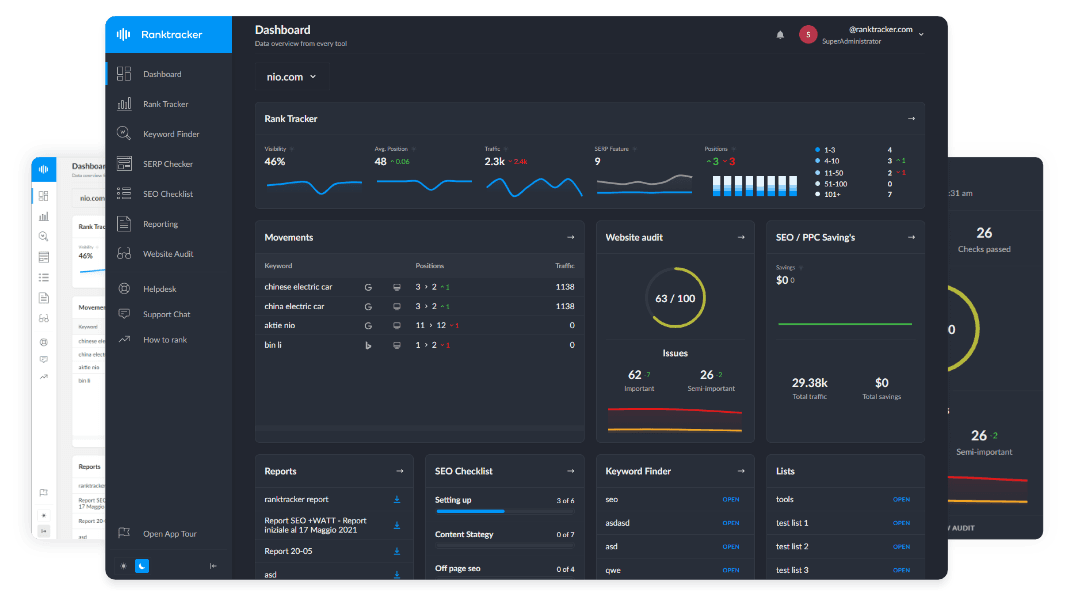Intro
The adoption of voice assistants is booming, with shoppers looking for smart speakers, displays, and hubs that can control lights, answer questions, and connect with thousands of apps and devices. Whether you’re a brand launching a new device, a retailer optimizing your product pages, or an integrator seeking new clients, strategic SEO is essential to ensure you’re found by buyers ready to invest in the connected home. Here’s how to dominate search and convert browsers into loyal customers—using Ranktracker’s proven approach.
Why SEO Matters for Voice Assistant Device Brands & Retailers
-
Research-heavy purchases: Buyers compare brands, features, integrations, and compatibility before making a choice.
-
Evolving search trends: New releases, privacy features, and smart home integrations constantly shape what people search for.
-
Trust and authority: User reviews, third-party comparisons, and certifications are critical for conversion.
1. Target Buyer, Feature, and Integration-Based Keywords
Go beyond “voice assistant device.” Optimize for how your customers search:
Examples:
-
“best smart speaker for home automation 2025”
-
“voice assistant with screen for elderly”
-
“Google Nest Hub vs Amazon Echo Show”
-
“affordable voice-activated speaker for music”
-
“voice assistant compatible with Apple HomeKit”
-
“setup voice assistant device [city/region]”
-
“privacy-focused smart speaker”
-
“voice assistant device with multi-room audio”
How to do it: Use Ranktracker’s Keyword Finder to identify high-volume, intent-rich, and feature-specific keywords. Map these to product, comparison, and service pages, covering integration (HomeKit, Alexa, Google Assistant), features (screen, camera, sound quality), and local setup.
2. Optimize Product, Category, and Comparison Pages
-
Meta titles & H1s: Use model, feature, and user intent (“Buy Google Nest Hub Max – Smart Display with Voice Assistant”).
-
Descriptions: Highlight USPs—compatibility, privacy, sound quality, supported apps, installation services, and warranty.
-
Schema markup: Use Product, Review, and FAQ schema for rich results (ratings, price, specs, FAQs).
-
Internal linking: Connect models, setup guides, integration how-tos, and troubleshooting pages.
3. Build Comparison & Authority Content
-
“Echo Dot vs Nest Mini: Which Smart Speaker Is Best for You?”
-
“How to Integrate Voice Assistant Devices with Smart Lighting”
-
“Top 5 Privacy-Focused Smart Speakers for 2025”
-
“Beginner’s Guide to Setting Up a Voice Assistant at Home”
-
“Best Voice Assistants for Seniors and Accessibility Needs”
These pages capture intent-driven shoppers and earn backlinks from tech and smart home blogs.
4. Build Trust With Reviews, Support, and Community
-
Enable user reviews and Q&A on product pages.
-
Highlight awards, certifications (Energy Star, privacy), and endorsements.
-
Share customer testimonials, case studies, and influencer videos.
-
Create a robust resource center: video setup guides, troubleshooting tips, and integration tutorials.
-
Respond quickly to reviews and support queries—demonstrate ongoing care.
5. Content Marketing & Link Building
-
Pitch products to tech review sites, home automation influencers, and YouTube reviewers.
-
Guest post on home technology, accessibility, and privacy blogs.
-
List your business in smart home directories and IoT product catalogs.
-
Use Ranktracker’s Backlink Checker to analyze competitor links and target high-authority sources.
6. Local SEO for Installers & Smart Home Integrators
-
Optimize your Google Business Profile (“Smart Home Installer,” “Voice Assistant Setup Service,” or “Home Automation Consultant”).
-
Add address, hours, phone, and real photos (installations, staff, device demos).
-
Collect and respond to Google reviews—ask clients to mention the devices and integrations installed.
-
Target “[service] [city/region]” and “near me” queries.
-
Get listed in local business directories and home tech partner programs.
7. Technical SEO & E-Commerce Optimization
-
Fast, mobile-optimized product and landing pages with high-quality images and video demos.
-
Filter and search by brand, integration, price, and feature.
-
Add canonical tags for duplicate or variant pages.
-
Highlight trust signals: free shipping, extended returns, support, and warranty badges.
8. Track, Analyze, and Refine With Ranktracker
Set up Ranktracker’s Rank Tracker for:
-
Device, feature, and comparison keywords (“best smart speaker 2025,” “Echo Show 10 review”)
-
Local search and installer intent (“voice assistant setup service Chicago”)
-
Guide and troubleshooting content
Monitor:
-
Organic visits to product, comparison, and setup pages
-
Rankings for high-intent and integration-specific keywords
-
Conversion rates and sales
-
Review volume, backlinks, and press mentions
Conclusion
Winning in the voice assistant device market takes more than just a great product—you need to be the most trusted and visible option at every step of the buyer journey. By targeting feature-rich and buyer-driven keywords, optimizing every product and comparison page, building trust through reviews and support, and tracking your progress with Ranktracker, your brand can consistently capture more buyers and become the go-to name in smart home voice technology.

